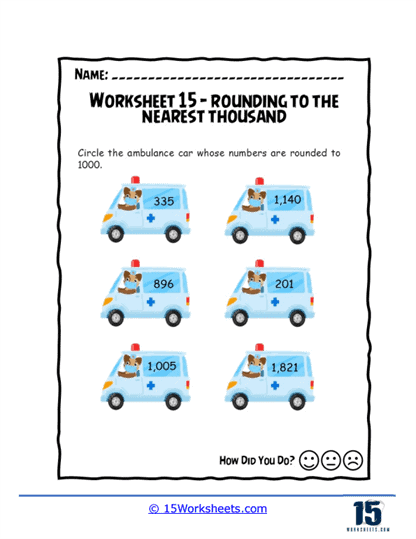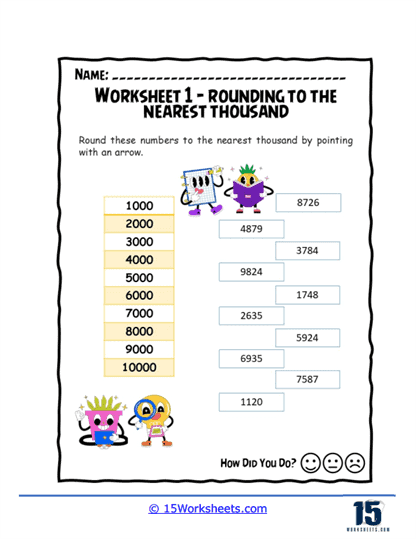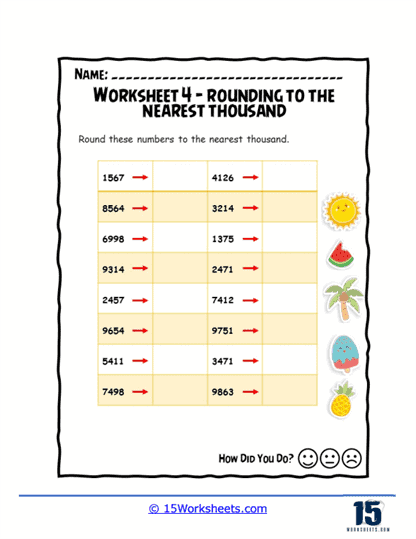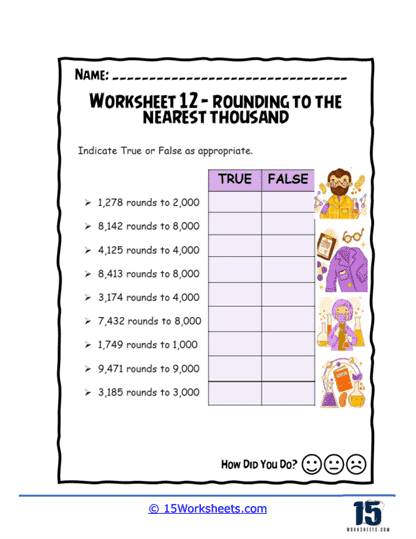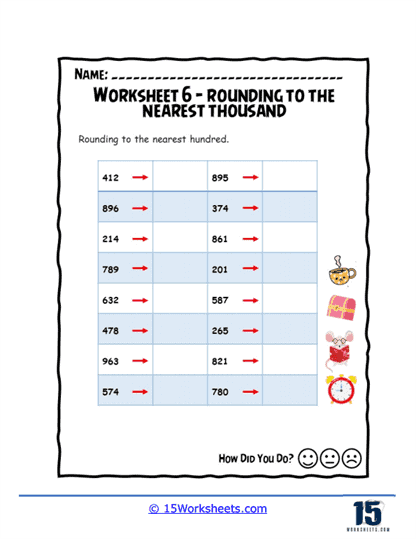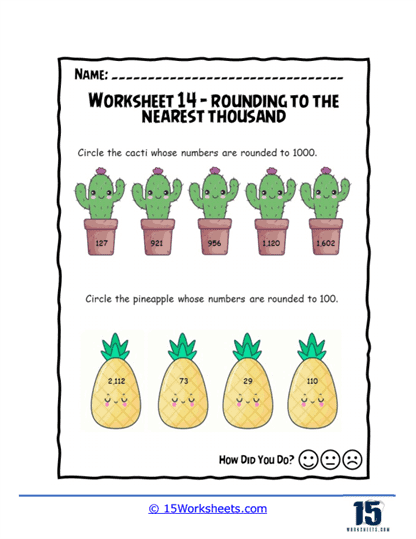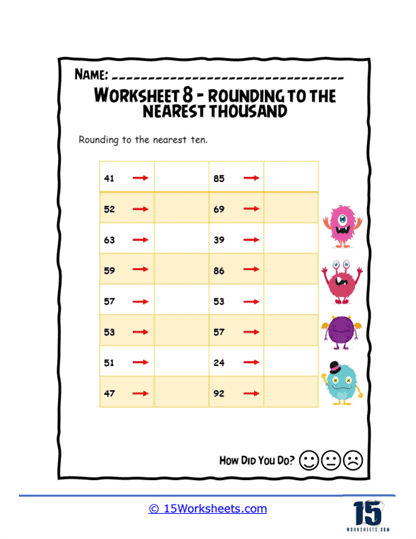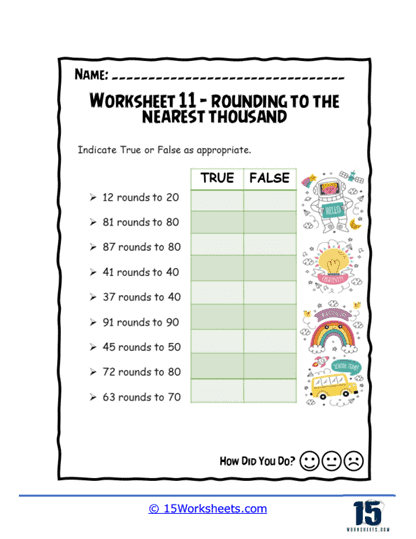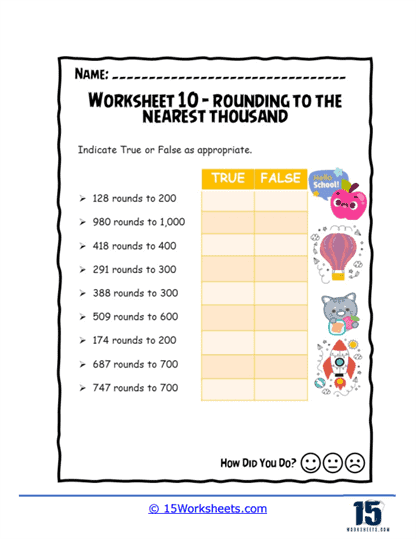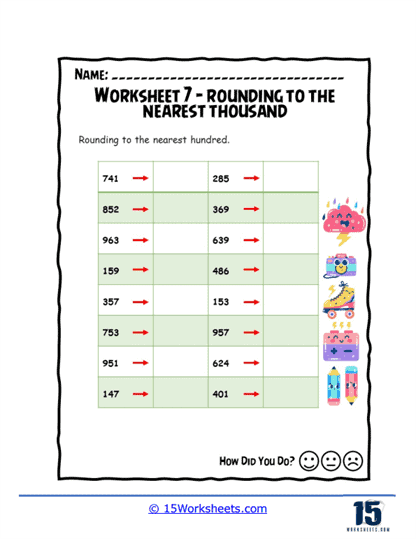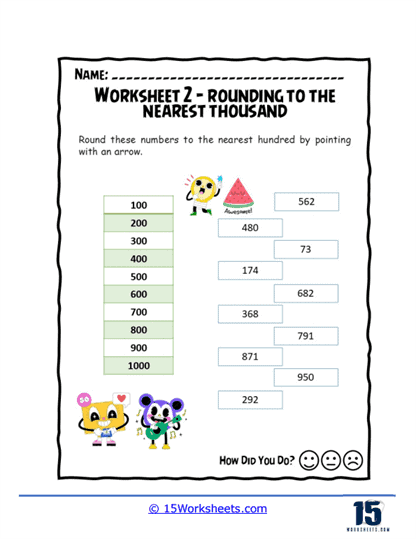Round to the Nearest 1000 Worksheets
About These 15 Worksheets
These worksheets can be used to help students practice and master the skill of rounding numbers to the nearest thousand. These worksheets present a variety of exercises and scenarios that engage students in the rounding process, ensuring they gain a solid understanding of how to determine which thousand a number is closest to. Whether students are dealing with three-digit, four-digit, or even larger numbers, these worksheets provide the practice needed to make rounding a natural part of their mathematical toolkit.
One common type of activity found on these worksheets involves simply rounding a given number to the nearest thousand. In these exercises, students are presented with numbers and must decide whether to round them up or down to the nearest thousand. For instance, when faced with a number like 4,879, students need to recognize that because the number is closer to 5,000 than 4,000, it should be rounded up. This type of straightforward rounding practice is foundational and helps students build confidence as they learn to quickly identify which thousand a number should be rounded to. It also reinforces their understanding of place value, which is crucial for rounding correctly.
Another interesting approach is the use of matching or pointing activities, where students are given a number and asked to match it with its rounded thousand or point to the correct thousand from a list of options. This interactive method not only tests their rounding skills but also engages them in a more dynamic way. These exercises often feature fun graphics or themes to make the learning process more enjoyable, encouraging students to see rounding as a game-like activity rather than just another math problem to solve. By incorporating visuals and a bit of fun into the exercises, these worksheets help keep students motivated and interested in practicing their rounding skills.
Worksheets that incorporate multiple-choice questions are also common in this collection. In these, students are given a number and several possible rounded options, and they must choose the correct one. This format is particularly useful for test preparation, as it mirrors the types of questions they might encounter in standardized tests. The multiple-choice format requires students to think critically and quickly, reinforcing their rounding skills in a high-pressure situation. It also provides an easy way for teachers to assess students’ understanding and identify areas where they might need more practice.
Some worksheets take rounding a step further by asking students to round numbers to the nearest thousand and then perform additional operations, such as addition or subtraction, with the rounded numbers. For example, students might be given two numbers, asked to round each to the nearest thousand, and then add the rounded figures together. This type of problem helps students see the practical application of rounding in simplifying calculations. By rounding numbers before adding or subtracting, students learn how rounding can be a useful tool in making mental math easier and faster. These exercises emphasize the utility of rounding in real-world situations, where quick estimates are often more practical than precise calculations.
There are also worksheets that focus on comparing the original number with its rounded form, encouraging students to understand the difference rounding makes. In these activities, students round a number and then compare it side by side with the original number, sometimes even determining how much was added or subtracted in the rounding process. This type of exercise helps students grasp the concept that rounding is about finding an approximate value that is close enough to the original number but easier to work with. It also reinforces the idea that rounding can sometimes lead to a slight loss of accuracy, which is an important consideration in situations where precision is crucial.
Word problems are another effective way these worksheets teach rounding to the nearest thousand. In these problems, students must apply their rounding skills to real-world scenarios, such as estimating the number of attendees at an event or the amount of money raised during a fundraiser. Word problems help students see the practical application of rounding and how it can be used to make large numbers more manageable in everyday situations. By solving these problems, students learn to translate their mathematical skills into real-life decision-making processes, which enhances their overall problem-solving abilities.
In addition to the more traditional rounding exercises, some worksheets incorporate creative activities like color-by-number tasks, where students round a number and then use the corresponding color to fill in a picture. This type of activity is particularly effective for younger students or those who benefit from visual and hands-on learning approaches. By combining math with art, these worksheets make rounding a more engaging and enjoyable experience. The process of coloring based on rounding results helps reinforce the concept in a way that sticks with students, making it more likely that they will remember the rounding rules in the future.
Another creative approach involves using themed visuals, such as rounding numbers on a series of objects like ambulances or cacti, and asking students to circle the correct rounded number. These worksheets are designed to capture students’ attention with fun and relatable themes, making the learning process more enjoyable. By associating numbers with familiar objects, students can better visualize the rounding process and see how it applies in different contexts. These types of activities also help break up the monotony of traditional math exercises, providing a fresh and engaging way to practice rounding.
True or False worksheets are another useful tool in teaching rounding. In these exercises, students are presented with statements that describe a number being rounded to a certain thousand, and they must determine whether the statement is true or false. This format encourages students to carefully consider each rounding rule and apply it to determine the correctness of the statement. True or False questions help reinforce the concept of rounding by requiring students to actively engage with the material and make decisions based on their understanding of the rules.
Whether through basic rounding practice, interactive matching games, multiple-choice questions, or creative color-by-number activities, these worksheets provide students with the comprehensive practice they need to master rounding to the nearest thousand. The variety of exercises ensures that students remain engaged and challenged, while the gradual increase in difficulty helps them build confidence and competence in rounding. By mastering these skills, students are better prepared for more advanced mathematical concepts and real-world applications where estimation and approximation are essential.


